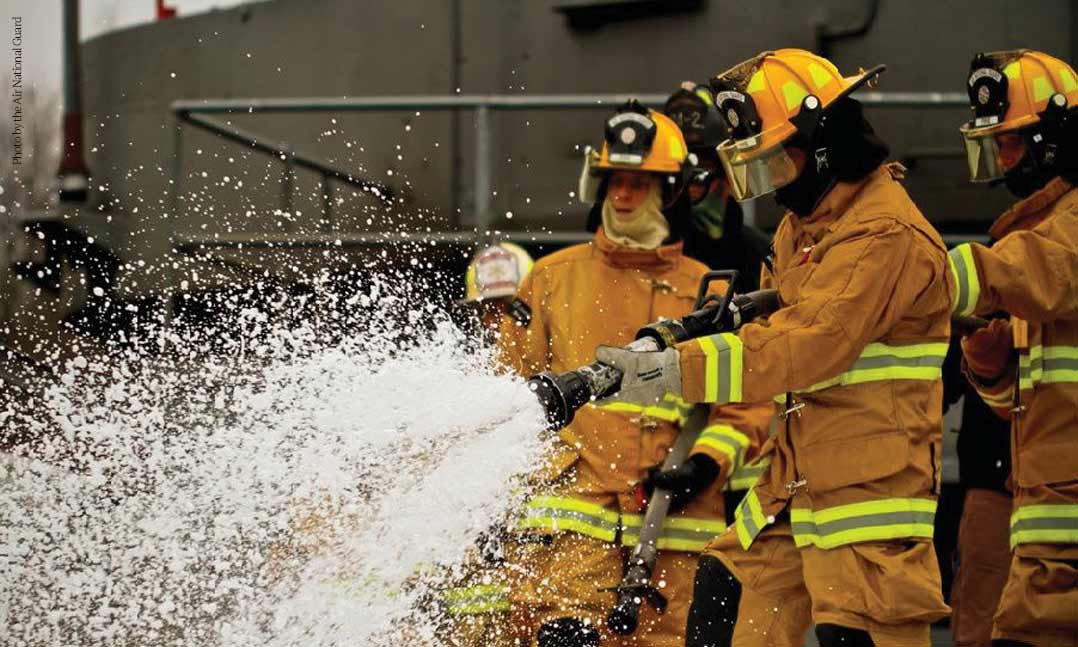A study published in July claims a type of polyfluoroalkyl substance (PFAS) used in the military is linked to testicular cancer in airmen. The toxin is a component in firefighting foam, such as aqueous film forming foam (AFFF), which is used to extinguish liquid-based fires.
A medical journal, Environmental Health Perspectives, published an article titled “A Nested Case–Control Study of Serum Per- and Polyfluoroalkyl Substances and Testicular Germ Cell Tumors Among U.S. Air Force Servicemen.” In the study, researchers stated that there is a significant connection between perfluorooctanesulfonic acid (PFOS), which is a PFAS, and testicular cancer.
Researchers claimed that the study was the “first to investigate” PFAS concentrations among Air Force service members and testicular cancer. Of U.S. men who have testicular cancer, more than 98 percent have testicular germ cell tumors.
 Air Force fire protection specialists of the New Jersey Air National Guard’s 177th Fighter Wing douse a training fire with a suppressant foam on Dec. 5, 2013, during an exercise at the Military Sealift Command Training Center East in Freehold, N.J. Findings of a study published in July 2023 suggested that there is a correlation between Air Force personnel who developed testicular cancer and firefighting foam used on military aircraft. Air National Guard photo.“Testicular cancer is the most frequently diagnosed cancer among U.S. active-duty servicemen and among young adult men in general,” according to an August report from the National Cancer Institute.
Air Force fire protection specialists of the New Jersey Air National Guard’s 177th Fighter Wing douse a training fire with a suppressant foam on Dec. 5, 2013, during an exercise at the Military Sealift Command Training Center East in Freehold, N.J. Findings of a study published in July 2023 suggested that there is a correlation between Air Force personnel who developed testicular cancer and firefighting foam used on military aircraft. Air National Guard photo.“Testicular cancer is the most frequently diagnosed cancer among U.S. active-duty servicemen and among young adult men in general,” according to an August report from the National Cancer Institute.
Military firefighters who were observed for the study were found to have “elevated concentrations” of PFAS. Blood samples of 530 airmen with testicular cancer were tested, and they were found to have elevated levels of PFOS compared to 530 cancer-free service members. Research also found that while higher levels of PFOS were associated with an increased risk of testicular cancer, other PFAS substances showed no signs of causing testicular cancer specifically.
The study also found that levels of PFAS in the blood were linked with being a firefighter or a service member stationed at a base with a high level of PFAS in the water supply. Researchers suggested that more tests be done to learn more about cancer related to PFAS.
In the September 2023 issue of VFW magazine, it was reported that military aviation ground and air crews have higher rates of cancer than the general U.S. population.
VFW continues to push for expanded presumptive conditionals related to PFAS exposure. To this end, VFW delegates passed VFW Res. No. 615 at the 124th VFW National Convention last year. According to the resolution, VFW will continue to “urge Congress to invest adequate resources to study, diagnose and treat conditions and illnesses associated with toxic exposure.”
The resolution also states that Congress should ensure that the Department of Defense discloses “known and potential toxic exposures during all military operations.”
This article is featured in the January 2024 issue of VFW magazine, and was written by Dave Spiva, associate editor for VFW magazine.